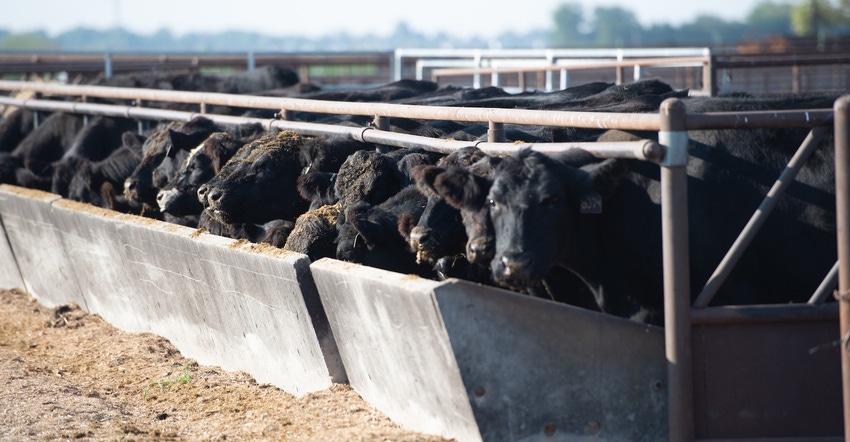Help producers save money by using feed and feed additives wisely to promote herd health while reducing environmental impact
June 9, 2021

Sponsored Content
Where cattle graze, how pastures are fertilized and stocking rates all help determine the sustainability levels of the beef operations you consult with as a nutritionist. Knowing and being able to trace the source of feed inputs can be important for producers. And then when feed gets to the animal, the digestibility and availability of it, how the feed is processed, and how animals can capture the most energy and nutrients from it will be very important in determining how sustainable an operation is.
You can help producers increase their sustainability efforts by recommending the feed and feed additives that will deliver excellent nutrition for the best price and have the least environmental impact.
All beef production is ultimately about converting feed resources into higher-value products, says Sara Place, PhD, chief sustainability officer, Elanco Animal Health. “The beauty of ruminant animals is that they take feedstuffs that humans cannot consume and then upcycle them into higher-quality food such as meat and other products like leather,” says Dr. Place. “It’s key to think about how that diet conversion happens.”
Elements of sustainability
Broadly speaking, there are three main areas of sustainability in beef operations: economic, environmental and social, says Dr. Place. “We can define sustainable beef operations as ones that are economically viable, practice environmental stewardship and work with others to advance the well-being of society,” she says. These three factors need to be in balance in order for an operation to be successful, not only from a sustainability standpoint but also from a business perspective.
Economic viability
Profitability is the number-one criteria for sustainability, says Dr. Place. “Any cattle producer wants to be profitable in the long-term, and the ability of an operation to turn a profit serves as the foundation for any sustainability effort.”
One way to optimize profitability is to use animal-centric ways to improve the conversion of feed resources into meat and increase carcass weight using the same amount of feed. These animal-centric actions could include improving cattle health and decreasing losses due to mortality and morbidity. Positive outcomes such as this can be achieved through genetic improvements and using better feeds and feed additives to enhance conversion. In addition to boosting profitability, taking actions that promote animal well-being can help improve sustainability.
Environmental stewardship
Regarding the GHG methane, which is emitted through cattle manure and belching, there is a system in place to enhance digestibility: starting cattle on grass and finishing them in feed yards.
“When cattle go to feed yards and eat a diet containing more fermentable carbohydrates like corn, they tend to reduce their methane emissions,” says Dr. Place. “They’re more feed efficient. And part of that efficiency is a result of not losing as many feed calories to methane; we’re capturing more of them in the animal. Essentially, we’re producing the same amount of beef today as in the mid-1970s, with a third fewer cattle.”
Societal well-being
Increasingly, society at large is emphasizing sustainability — particularly through reducing GHG emissions. However, beef producers are not necessarily tracking those improvements on a large scale today.
“As an industry, we haven’t talked much about our sustainability successes and what we’re doing to advance sustainability because most people in this industry are very humble,” says Dr. Place. “They’re also not necessarily viewing what they do to care for their animals through a sustainability lens.”
Dr. Place believes that the future will bring improved techniques to calculate the success of sustainability efforts. “As we monitor more emissions and other new measures, we’ll get more innovations in those spaces, whether it’s new ways to lower methane emissions from cattle, or methane and nitrous oxide from their manure,” she says. “There will likely also be new practices in feed production that would lower emissions or increase carbon sequestration.”
Enhancing or adopting sustainability efforts on a beef operation has the potential to accomplish two things: improve the business over time, thereby making it more attractive to pass on to the next generation; and improve relationships with a broader audience. This audience includes the end users of beef who are increasingly interested in what companies and individuals are doing to advance sustainability efforts, as well as institutions that lend beef producers money, intermediary processors and others.
“Beef industry organizations have recognized the need to advance sustainable practices and have set various stewardship and sustainability goals,” says Dr. Place. “It’s an example of good leadership and being proactive to stay ahead of the game and communicate openly with stakeholders.”
Elanco Animal Health has also made a commitment through its Healthy PurposeTM initiative to create more resilient food systems by enabling 57 million more people to access their annual nutritious protein needs. At the same time, the company will remove 21 million tons of GHG emissions from customer farms while reducing its own impact on the planet.
Improving cattle diets
The feed efficiency benefit of Rumensin® allows producers to use feed resources more wisely, says Dr. Place. Additionally, it is a cost-effective feed additive that improves feed efficiency by providing more energy from the ration.1 Research demonstrates that Rumensin improves feed efficiency by 4% and provides a net return of $23.13/hd.2 Dr. Place shares, “Rumensin helps enhance the efficiency of the rumen system to get more of the volatile fatty acids (VFAs) that we want from cattle and increase the energy efficiency of rumen fermentation.”
Rumensin has other benefits, including preventing and controlling coccidiosis. “This is a sustainability benefit because it means fewer animal mortalities and less feed energy being used to fight an infection,” says Dr. Place. “Animals that are sick are not going to be performing at their best.”
Talk with your producers about practical ways to optimize feed costs, improve feed efficiency and add to their bottom lines. Let them know what’s most feasible for their situations to maintain adequate weight gain and achieve optimal nutrition for their cattle.
Your Elanco technical consultant can provide you with more information about how to use Rumensin to help improve feed efficiency and make the beef operations you work with more sustainable.
The label contains complete use information, including cautions and warnings. Always read, understand and follow the label and use directions.
CAUTION: Consumption by unapproved species or feeding undiluted may be toxic or fatal. Do not feed to veal calves.
Growing beef steers and heifers fed in confinement for slaughter:
For improved feed efficiency: Feed 5 to 40 g/ton of monensin (90% DM basis) continuously in a complete feed to provide 50 to 480 mg/hd/d.
For the prevention and control of coccidiosis due to Eimeria bovis and Eimeria zuernii: Feed 10 to 40 g/ton of monensin (90% DM basis) continuously to provide 0.14 to 0.42 mg/lb of body weight/d, depending upon severity of challenge, up to a maximum of 480 mg/hd/d.
Growing beef steers and heifers on pasture (stocker, feeder, and slaughter) or in a dry lot, and replacement beef and dairy heifers:
For increased rate of weight gain: Feed 50 to 200 mg/hd/d of monensin in at least 1.0 lb of Type C medicated feed. Or, after the 5th day, feed 400 mg/hd/d every other day in 2.0 lbs of Type C medicated feed. The Type C medicated feed must contain 15 to 400 g/ton of monensin (90% DM basis). Do not self feed.
For the prevention and control of coccidiosis due to Eimeria bovis and Eimeria zuernii: Feed at a rate to provide 0.14 to 0.42 mg/lb of body weight/d, depending upon severity of challenge, up to a maximum of 200 mg/hd/d. The Type C medicated feed must contain 15 to 400 g/ton of monensin (90% DM basis).
Free-choice supplements: Approved supplements must provide not less than 50 nor more than 200 mg/hd/d of monensin.
Beef cows:
For improved feed efficiency when receiving supplemental feed: Feed continuously at a rate of 50 to 200 mg/hd/d. Cows on pasture or in drylot must receive a minimum of 1.0 lb of Type C medicated feed/hd/d. Do not self feed.
For the prevention and control of coccidiosis due to Eimeria bovis and Eimeria zuernii: Feed at a rate of 0.14 to 0.42 mg/lb of body weight/d, depending upon severity of challenge, up to a maximum of 200 mg/hd/d.
1Richardson L, Raun A, Potter E, et al. 1976. Effect of monensin on rumen fermentation in vitro and in vivo. J. Anim. Sci. 1976;43:657–664.
2Elanco Animal Health. Data on file.
Healthy Purpose, Rumensin, and Elanco and the diagonal bar logo are trademarks of Elanco or its affiliates. © 2021 Elanco.
PM-US-21-1426
About the Author(s)
You May Also Like



